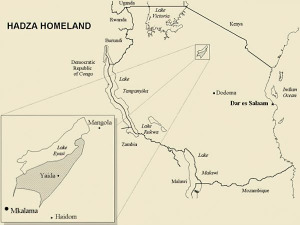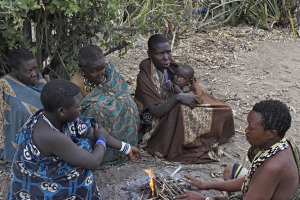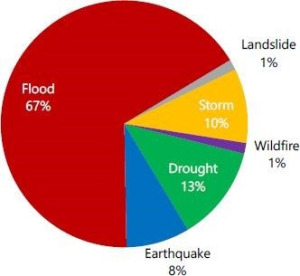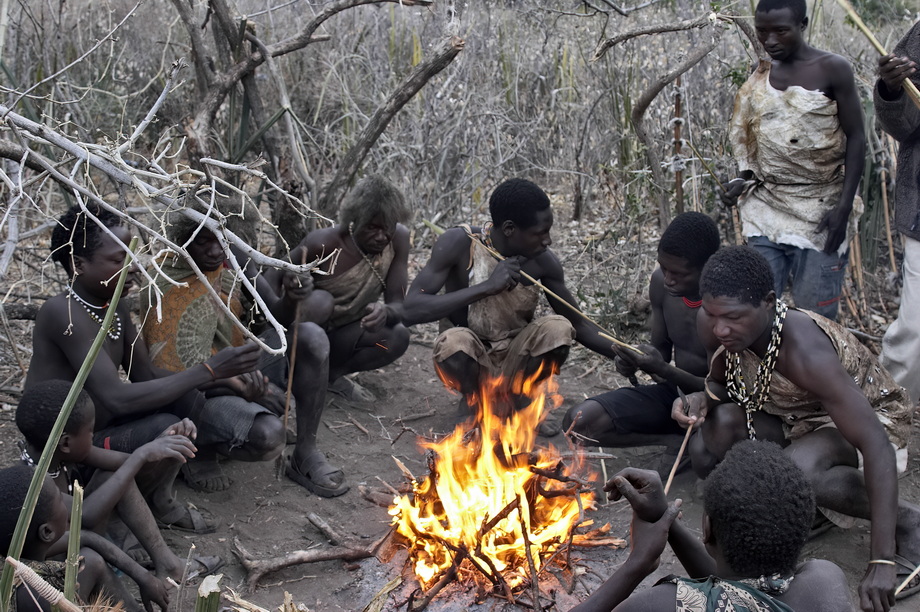Left Behind in Climate Change and Justice: Social Economic Impact of Climate Change on Indigenous Communities: A case of Hadzabe Indigenous people of Tanzania
A lot of climate change coverage and advocacy in defense of indigenous communities is largely focused on other parts of the world such as the Amazonian and Andean communities yet little attention is given to African indigenous communities. Without immediate action, we warn, the Hadzabe livelihoods and communities could gradually be wiped into extinction.
Author: Eva Kihupi, Junior Associate, Governance and Economic Policy Center
(Featured photos sourced from: Africa 101 Last Tribes online website-https://www.101lasttribes.com/tribes/hadzabe.html)
1.0 Introduction to Climate Change and Indigenous Communities
Africa has a lot of indigenous groups critically exposed to the dangers of climate change with little support. These constitute the left behind in climate governance and the quest for climate Justice. This short analytical study and brief highlights the relevance of taking action to mitigate the problems created by climate change on African indigenous communities, with a focus case on the Hadzabe indigenous communities of Tanzania.
Amidst a world transformed by climate’s embrace, Indigenous communities bear the deepest scars. Their ancestral lands, rich in spirit, face unprecedented challenges. In their resilience lies a profound wisdom, urging us to unite for a future where all thrive in harmony.
Current studies show a positive correlative evidence of climate change’s impacts on increased temperatures and declining biodiversity in sensitive nature ecosystems. This makes indigenous groups the first group to be directly affected and more disadvantaged by the negative impacts of climate change due to their direct reliance on the natural environment. Moreover, the impacts of climate change are more severe, long lasting, socially disruptive on indigenous communities than other population groupings.
According to the United Nations “Indigenous communities, peoples and nations are those which, having a historical continuity with pre-invasion and pre-colonial societies that developed on their territories, consider themselves distinct from other sectors of the societies now prevailing on those territories, or parts of them.
Indigenous people are therefore distinct social and cultural groups that share collective ancestral ties to the lands and natural resources where they live and occupy. By nature, the indigenous people are heavily reliant on their natural environment and local ecosystems for livelihoods and survival.
The UN further estimates that the total net impact of climate change on indigenous communities is in billions of dollars and intergenerational. Despite being the least polluters, the indigenous communities are paying heavily for the climate change crimes and damages that they never caused. Their lands, dwellings, livelihoods and cultures are being disrupted and wiped out. Their future generations may never exist or even live to enjoy their cultural heritage.
While the impacts of climate change on indigenous communities are almost similar, a lot of global climate change coverage and advocacy in defense of indigenous communities is largely focused on other parts of the world such as the Amazonian, Andean and pacific communities.
Little attention is given to African indigenous communities. Yet Africa has a lot of indigenous groups critically exposed to the dangers of climate change with little support. In our assessment, these constitute the left behind in climate governance and the quest for climate Justice.
2.0 Why Indigenous Communities Matter in Climate Change Justice
Indigenous peoples comprise less than five percent of the global population but protect more than 80 percent of its biodiversity. Indigenous people play a great importance in climate solutions alongside their need to have access to resources[1].
When the rights of Indigenous peoples are recognized, secured, and protected, rates of deforestation tend to be lower and carbon stocks tend to be higher than in forests managed by other actors. Secure rights for community forest guardians can also improve ecosystem integrity, protect biodiversity, and enhance public health
Climate change exacerbates the difficulties already faced by indigenous communities. This includes social and economic marginalization, loss of ancestral land for hunting, gathering and water resources for livelihood. Encroachment from external actors aggravating, human rights violations and discrimination based on cultural differences.
By addressing the critically climate change problems and concerns facing indigenous communities equally, governments and the world can strike a double win of achieving long lasting solutions to climate change and at the same time contributing to securing the unique cultural diversity and livelihoods of indigenous communities for future generations.
3.0 Climate Change and the Hadzabe People of Tanzania

The Hadzabe people reside in a 4000 km2 area around the shores of Lake Eyasi in Northern Tanzania, East Africa. The total small population size of approximately 1000 to 2,000 individuals, has shown no major disruption during the past 100 years. According to the 2015 National Census report the Hadzabes range between 1,200 to 1,500 but this number has been dropping.
Only around 150 to 200 individuals of these, however, currently practice a predominantly hunting and gathering way of life, meaning that the bulk of their diet is derived from wild plant foods and game animals. Because of climate change related factors, many have been either displaced or forced to abandon their ancestral lands and culture and escaped to urban centers in search for better livelihoods.
The Hadzabe are more prone to the impacts of climate change than any other community because they are very highly dependent on the environment and climate compared to other social groupings in Tanzania.
Over the years, the Hadzabe’s have been facing the vagaries of climate change head-on and yet very little efforts are made to highlight their plight and address the climate change risks that they face. The risks are socio-economic, health and cultural in nature yet have serious human rights and justice violations connotations that are silently overlooked.
Their livelihood is entwined with the climatic environment where they live, and therefore it is important to have appropriate means to tackle the impacts of climate change and its adverse effects on these indigenous people.
Environmental degradation and livelihoods
 Firstly, the rising temperatures and extended droughts have resulted in a loss of vegetation and negatively impacted gathering and hunting activities undertaken by the Hadzabe people. Their hunting and eating habits have changed as they now have to turn to unconventional hunting methods and eating of endangered animal such as monkeys, baboons and rare bird species to compensate for the dwindling plant and animal species that previously provided food. Increasingly the Hadzabe are gradually becoming a danger to the animals and an ecosystem that they protected for many generations earlier.
Firstly, the rising temperatures and extended droughts have resulted in a loss of vegetation and negatively impacted gathering and hunting activities undertaken by the Hadzabe people. Their hunting and eating habits have changed as they now have to turn to unconventional hunting methods and eating of endangered animal such as monkeys, baboons and rare bird species to compensate for the dwindling plant and animal species that previously provided food. Increasingly the Hadzabe are gradually becoming a danger to the animals and an ecosystem that they protected for many generations earlier.
Health and morbidity risks
Moreover, the health of the Hadzabe indigenous people is deteriorating as they no longer get their livelihood from nature. The Hadzabe’s are very well known to feed on meat from wild game, honey, and plants, including tubers, berries, and baobab fruit[1]. For the Hadzabe, the phrase “food is medicine” is applicable and yet the increased climate impacts like heat waves, storms and flash floods have wiped out their food sustenance. Because of climate change, the flower bearing trees are rare and the bees are dying or migrating to distant places in search for green forest cover.
The already inadequate access to health facilities such as hospitals amidst declining immunity has caused more danger for the indigenous people who live in the wilderness and have to roam deeper in search for food. According to medical reports from the nearest medical facilities such as the Haydom Lutheran Hospital, the morbidity and mortality rates amongst this small Hadzabe community in Yaedachin Valley has increased.
 The level of alcoholism and substance abuse has increased as they look for alternative ways to survive the harsh living conditions in a changing natural environment. The leading causes of death are malaria, respiratory diseases, anemia and cardio-circulatory disease and maternal mortality rates amongst the women and children.[2]
The level of alcoholism and substance abuse has increased as they look for alternative ways to survive the harsh living conditions in a changing natural environment. The leading causes of death are malaria, respiratory diseases, anemia and cardio-circulatory disease and maternal mortality rates amongst the women and children.[2]
Limited supportive infrastructure, social services and opportunity
Furthermore, lack of supportive social infrastructure such as clean water sources have increased vulnerability to the negative impacts of climate change. The water streams have dried up and the few surviving are shared with wild animals, increasing the risks of contamination and disease. Women and children have to walk long distances in search of water and this has disrupted their traditional family settings, learning and increased to exposure to gender-based violence.
Enhanced climate induced emergencies affecting for Hadzabe

The increased droughts and erratic rainfalls have increased vulnerability and occurrence of natural climate driven disasters such as flush floods affecting the Yaedachini Valley where the Hadzabe live. According to the Tanzania Prevalence of Natural Disasters Report (1980-2022), Northern Tanzania now suffers from recurrent floods and droughts, and the frequency (and severity) of events has been increasing.
The adjacent pie chart shows the percent share by type of natural disasters recorded in Northern Tanzania between 1980-2022. According to this statistics floods and drought account for more than 71% of the total disasters recorded. This proves that the impacts of climate change are affecting the drier part of Northern Tanzania, where the Hadzabe live more than any other parts of the Country.
The Hadzabes live in Yaedachini Valley on the floors of the Eastern Rift Valley Escarpments located in Babati, Hanang, Haydom, Mbulu districts corridor of Manyara region which have become more susceptible to drought and flash floods.
The recent examples of enhanced climate induced emergencies were the flash floods and mudslides which affected Babati and Mbulu district in 2023 killing hundreds and living thousands homeless[1]. During these last flash storms and floods, it is estimated that at least 60% of the Hadzabe dwelling places in the Yaeda valley were affected and many left without food and shelter. The consequences to their livelihoods were more severe as they are directly more reliant on the natural environment than any of their neighboring social groupings. Yet very little national and global coverage and attention was provided.
The Natural disasters reports from Tanzania’s Prime Minister’s Office confirms, the severity of climate change related disasters such as floods has been increasing in the country. For example, the heavy rains and floods that occurred in Tanzania between 28th March and 28th April 2024 claimed around 155 lives. This was so far the highest number of flood related deaths ever recorded in the country[2]. The damages were more severe in drought prone regions such as Manyara region. If not addressed therefore, the Hadzabes and other indigenous groups in these disaster-prone areas could be wiped out.
Climate Injustice implications to the Hadzabe
Further, climate change has significant human rights and justice implications on indigenous groups. The indigenous Hadzabe people are facing numerous injustices and violations of their socio, economic and cultural rights due to climate change. Their socio-economic rights are not guaranteed, and their indigenous lands are not protected, putting them at risk of extinction. They are also facing threats to their right to food, shelter, and ancestral lands, as they may be forced to leave their traditional lands in search of alternative livelihoods.
Climate induced migration and cultural injustices
The Hadzabe’s culture is being adulterated by new communities such as the cattle keeping and farming Datoga tribes who are moving into Hadzabe lands in search for pasture and new settlement. The numbers of new comers are increasing while their Hadzabe numbers are dwindling, making them increasingly a minority and vulnerable[1]. Their location in hard-to-reach areas and lack of access to education and formal skills has increased their economic marginalization as an indigenous group and limits their opportunities to employment and a better future.
In the midst of all these, there are critical policy and governance actions that must take and the international community must support to bring the Hadzabe from the behind to the front. From near extinction to future survival.
4.0 Recommendations for action
- Tanzania government must recognise Hadzabe as an indigenous group for protection by both national and international mechanisms against climate change and extinction. Despite voting in favor of the UN Declaration of the Rights to Indigenous peoples, Tanzania does not recognize the existence of any indigenous peoples in the country and there is no specific national policy or legislation on indigenous peoples per se. The absence of such makes protection of the Hadzabe with in the ambits of national and international frameworks weak. On the contrary, a number of policies, strategies and programs that are misaligned to the interests of the indigenous peoples in terms of access to land and natural resources, basic social services and justice are continuously being developed, resulting in a deteriorating and increasingly hostile environment for both pastoralists and hunter gatherers[2]. In a recent move in 2022 and 2023, the government relocated hundreds of Masai and Hadzabe families from the Loliondo Ngorongoro area to Tanga, hundreds of kilometers away from the ancestral land[3]. This was to pave way for expansion of private game hunting grounds of a Dubai based firm. This move was widely condemned by Human and Land rights defense organizations, as reflective of the risks that indigenous groups face in Tanzania. Despite global condemnations, the government did not change its decision.
- Tanzania government must establish a dedicated fund towards climate change mitigation and adaptation measures targeting the Hadzabe. The Tanzanian Government and parliament must allocate a special vote in its national budget to cater for climate change mitigation, adaptation and protection of indigenous communities at frontline of climate change. While the government funds climate change and disaster related activities through line Ministries, Departments and Agencies such as the Prime Minister’s Office, the Vice President’s Office- Environment, Ministry of Tourism and Natural resources etc., it is evident that such funding lines can be conflated and blurred due to over competing priorities. The net consequences have been that less dedicated funding is reaching the extremely vulnerable and left behind in climate change such as the Hadzabe who desperately need it for survival. Tanzania is yet to establish a fully-fledged National Climate Fund and the current climate change related funding has been largely foreign sourced and quite unsustainable[4].
- The UN and other international agencies must dedicate percentage of the Loss and Damage Fund to cater for indigenous groups including the Hadzabe in Tanzania. During the COP27 in Egypt, the United Nations committed to setting up a climate loss and damage fund. While as the details of this Fund are still unclear, the framework for access of these funds is still being developed. This provides an opportunity for putting guard rails as to how indigenous groups such as the Hadzabe will benefit. Reports from climate champions indicate that a very small fraction of funding is currently directed towards Indigenous Peoples and Local Communities (IPLC) for securing land rights and managing forests in tropical regions. Over the past decade, a minimal portion of the resources designated to support IPLC’s land rights and forest management actually involved an IPLC organization. This accounts for an insignificant share of the overall climate change assistance. Additionally, from the financial commitments made during the COP26 IPLC Forest Tenure Pledge for the period between 2021 and 2025, only a minor percentage of those funds has been utilized[5].
- Tanzania government must provide adequate infrastructure and social services like health, water services, and education for future sustainability. The Tanzanian government in collaboration with other state actors or non-state actors such as CSO, community-based organization must provide supportive social-economic infrastructure[6] such as wells, boreholes, and water tanks to the Hadzabe communities. This will help provide the Hadzabe with access to clean and reliable sources of water and opportunities for learning and acquiring new skills to confront climate change. Alternative means of food must be equally provided to complement the dwindling wild sources.
- Scale up indigenous conservation and tame nugatory land grabbing of indigenous lands. The government ministries and departments responsible for environment, conservation and lands must address the persistent land grabbing and encroachment on ecosystems that support indigenous groups such as the Hadzabe. Since the indigenous people heavily rely on the natural environment to sustain themselves it must be a priority to preserve and even promote indigenous conservation of their natural environment. Proclaiming more places as conversation areas and restricting deforestation or intrusion and allowing access for the indigenous communities to live and enjoy the natural habitats, such as Yaeda Chini valley will be a game changer in ensuring continued existence of the Hadzabe[7].
- Create space at the table for the Hadzabe, to directly speak and advocate for their interests at both national and international levels. Creating forums and opportunities for the Hadzabe to sit at the table as active participants in national climate change dialogues spaces would help raise awareness of the magnitude of their plight at national level. Having the Hadzabe constitute part of the National Delegations to international forums like the forthcoming COPs, is essential in highlighting their concerns at international level and creating international consensus. Direct representation in forums like parliament and the United Nations would amplify their voices and influence suitably tailor-made solutions to their needs. This will empower the Hadzabe to advocate for effective climate change mitigation policies and support based on their firsthand experiences.
References and notes
- IMF (2023), ‘Building Resilience to Climate Change’. Country Report No 23/154. https://doi.org/10.5089/9798400241772.002
- The Water Supply and Sanitation Act, 2019 (s. 4). Available at https://tanzlii.org/akn/tz/act/2019/5/eng@2019-02-22
- Khatibu, F. A., Msami, J., Mchallo, I and Gontako, J (2022, June). ‘Climate Finance Availability and Access in Tanzania’ (Issue Brief No 04/2022) :https://www.repoa.or.tz
- https://education.nationalgeographic.org/resource/the–hadza–of–tanzania/
- 29 No. 1 (2022): ‘Tanzanian Journal of Population Studies and Development’. https://doi.org/10.56279/tjpsd.v29i1
- Laltaika, E. & Parmello, S. (2012). ‘International Work Group for Indigenous Affairs: Indigenous Peoples in Tanzania’. https://www.iwgia.org/en/tanzania/897-update-2011-tanzania
- Race to Resilience. ‘Indigenous Peoples and The Race to Secure Self-Determined Finance’: https://climatechampions.unfccc.int/system/indigenous-peoples-finance/
- National Geographic, (2023): ‘Evolution of Diet – The Hadza of Tanzania’. https://education.nationalgeographic.org/resource/the-hadza-of-tanzania/
- National Library of Medicine (2018). ‘Cause-specific mortality patterns among hospital deaths in Tanzania, 2006-2015’. https://doi.org/10.1371%2Fjournal.pone.0205833
- Association of Member Episcopal Conferences in Eastern Africa (2023). ‘TANZANIA: TEC Sends Humanitarian Aid and Condolences after Deadly Mudslide Hits Hanang Manyara’. https://communications.amecea.org/index.php/2023/12/08/tanzania-tec-sends-humanitarian-aid-and-condolences-after-deadly-mudslide-hits-hanang-manyara/
- Lasteck, A., (2024). ‘Tanzania floods and landslides kill more than 150’. BBC News 25 April https://www.bbc.com/news/world-africa-68896454
- Karashani, B (2022). ‘Tanzania spends millions to move, build new life in Tanga for Loliondo Maasai’ The East African. https://www.theeastafrican.co.ke/tea/news/east-africa/tanzania-relocates-loliondo-maasai-to-tanga-3860046
- Dave, ‘The Hadzabe of the Yaeda Valley’ A Step Ahead. https://www.astepahead.es/the-hadzabe-of-the-yaeda-valley/
[1] Tanzanian Journal of Population Studies and Development, Vol. 29 No. 1, 2022: 44-64
[2] https://www.iwgia.org/en/tanzania/897–update–2011–tanzania
[3] https://www.theeastafrican.co.ke/tea/news/east-africa/tanzania-relocates-loliondo-maasai-to-tanga-3860046
[4] https://www.repoa.or.tz/wp-content/uploads/2022/10/Climate-finance-availability-and-access-in-Tanzania-.pdf
[5] https://climatechampions.unfccc.int/system/indigenous-peoples-finance/
[6] Section 23 of the water supply and sanitation act, 2019
[7] https://www.astepahead.es/the–hadzabe–of–the–yaeda–valley/
[1]https://communications.amecea.org/index.php/2023/12/08/tanzania-tec-sends-humanitarian-aid-and-condolences-after-deadly-mudslide-hits-hanang-manyara/
[2] https://www.bbc.com/news/world-africa-68896454
[1] https://education.nationalgeographic.org/resource/the-hadza-of-tanzania/
[2] https://www.ncbi.nlm.nih.gov/pmc/articles/PMC6209209/
[1] https://climatechampions.unfccc.int/system/indigenous-peoples-finance/

